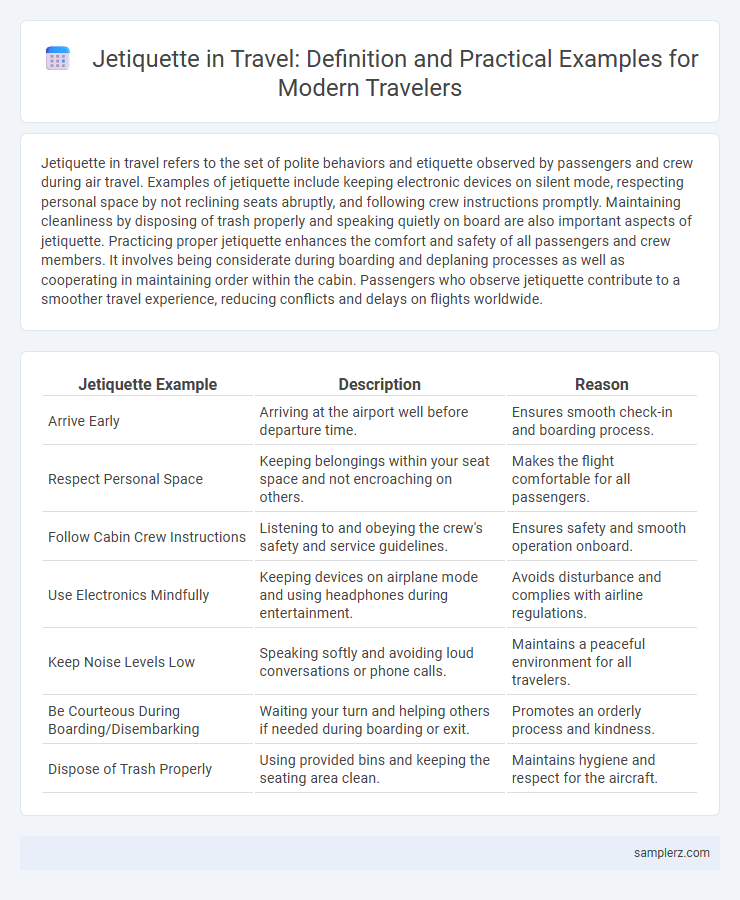Jetiquette in travel refers to the set of polite behaviors and etiquette observed by passengers and crew during air travel. Examples of jetiquette include keeping electronic devices on silent mode, respecting personal space by not reclining seats abruptly, and following crew instructions promptly. Maintaining cleanliness by disposing of trash properly and speaking quietly on board are also important aspects of jetiquette. Practicing proper jetiquette enhances the comfort and safety of all passengers and crew members. It involves being considerate during boarding and deplaning processes as well as cooperating in maintaining order within the cabin. Passengers who observe jetiquette contribute to a smoother travel experience, reducing conflicts and delays on flights worldwide.
Table of Comparison
| Jetiquette Example | Description | Reason |
|---|---|---|
| Arrive Early | Arriving at the airport well before departure time. | Ensures smooth check-in and boarding process. |
| Respect Personal Space | Keeping belongings within your seat space and not encroaching on others. | Makes the flight comfortable for all passengers. |
| Follow Cabin Crew Instructions | Listening to and obeying the crew's safety and service guidelines. | Ensures safety and smooth operation onboard. |
| Use Electronics Mindfully | Keeping devices on airplane mode and using headphones during entertainment. | Avoids disturbance and complies with airline regulations. |
| Keep Noise Levels Low | Speaking softly and avoiding loud conversations or phone calls. | Maintains a peaceful environment for all travelers. |
| Be Courteous During Boarding/Disembarking | Waiting your turn and helping others if needed during boarding or exit. | Promotes an orderly process and kindness. |
| Dispose of Trash Properly | Using provided bins and keeping the seating area clean. | Maintains hygiene and respect for the aircraft. |
Understanding Jetiquette: The Basics of Air Travel Etiquette
Respecting personal space by keeping carry-on items within designated areas and avoiding excessive noise promotes a pleasant atmosphere for all passengers. Following seatbelt signs and complying with crew instructions ensures safety and smooth operations during the flight. Being mindful of hygiene and refraining from strong odors or reclining seats abruptly contributes to courteous behavior on board.
Boarding the Plane: Courteous Behavior at the Gate
Standing patiently in line and allowing passengers with priority boarding to go first demonstrates proper jetiquette at the gate. Keeping personal belongings organized and avoiding crowding the boarding area ensures a smooth process for everyone. Polite communication with airline staff and fellow travelers fosters a respectful and efficient boarding experience.
Luggage Manners: Handling Carry-Ons and Overhead Bins
Proper jetiquette in travel includes managing carry-on luggage with consideration by placing smaller bags under the seat and larger ones in overhead bins efficiently to maximize space. Passengers should avoid overpacking carry-ons to prevent blocking aisles and delays during boarding. Respect for fellow travelers involves retrieving bags promptly upon landing to keep the overhead bins accessible.
Seating Courtesy: Respecting Personal Space on Flights
Respecting personal space on flights is essential for a comfortable travel experience and is a key aspect of jetiquette. Passengers should avoid encroaching on neighboring seats by keeping belongings within arm's reach and refraining from reclining seats abruptly during meals or rest periods. Maintaining seating courtesy helps minimize discomfort and fosters a respectful environment for everyone on board.
In-Flight Communication: Polite Interactions with Crew and Passengers
Maintaining polite interactions with crew and fellow passengers enhances the overall in-flight experience by fostering a respectful environment. Using courteous language, listening attentively, and following crew instructions ensures smooth communication and cooperation during the flight. Demonstrating patience during service and addressing issues calmly promotes positive relationships and reduces travel stress.
Noise Control: Keeping Your Volume Down During Travel
Maintaining low noise levels during travel respects fellow passengers and enhances the overall comfort of the journey. Using headphones for music or movies and speaking softly in shared spaces prevents disturbances in airplanes, trains, and buses. Effective noise control promotes a peaceful environment, reducing travel fatigue and ensuring a more enjoyable experience for everyone.
Food and Drink Etiquette: Eating Considerately on the Plane
Eating considerately on the plane involves selecting low-odor foods to avoid disturbing fellow passengers and using a napkin to maintain cleanliness. Passengers should avoid strong-smelling items like garlic or fish and finish their meals quietly to respect the cabin environment. Offering to share snacks or help with food-related trash also demonstrates good jetiquette during air travel.
Hygiene Habits: Keeping Clean and Fresh in the Air
Maintaining personal hygiene on flights enhances comfort and respect for fellow travelers, such as using sanitizing wipes to clean hands and tray tables before meals. Carrying travel-sized deodorant and facial mist helps stay fresh during long journeys, preventing unpleasant odors in confined cabin spaces. Regular handwashing and using hand sanitizer reduce the spread of germs, promoting a healthier environment throughout the flight.
Tech Use Etiquette: Using Devices Responsibly During Flights
Using devices responsibly during flights involves switching phones to airplane mode, limiting phone calls, and utilizing headphones to minimize noise disturbance to fellow passengers. Passengers should avoid streaming high-bandwidth content or excessive device use to preserve onboard Wi-Fi bandwidth and maintain a conducive environment for everyone. Following airline guidelines on electronic device usage ensures safety and comfort throughout the flight.
Disembarking Gracefully: Exiting the Plane with Courtesy
Exiting the plane with courtesy involves waiting patiently for passengers in front to gather their belongings before standing. Keeping aisles clear and limiting sudden movements ensures a smooth, respectful flow toward the exit. Offering assistance to elderly or disabled travelers exemplifies proper jetiquette, enhancing overall passenger experience during disembarkation.

example of jetiquette in travel Infographic
 samplerz.com
samplerz.com